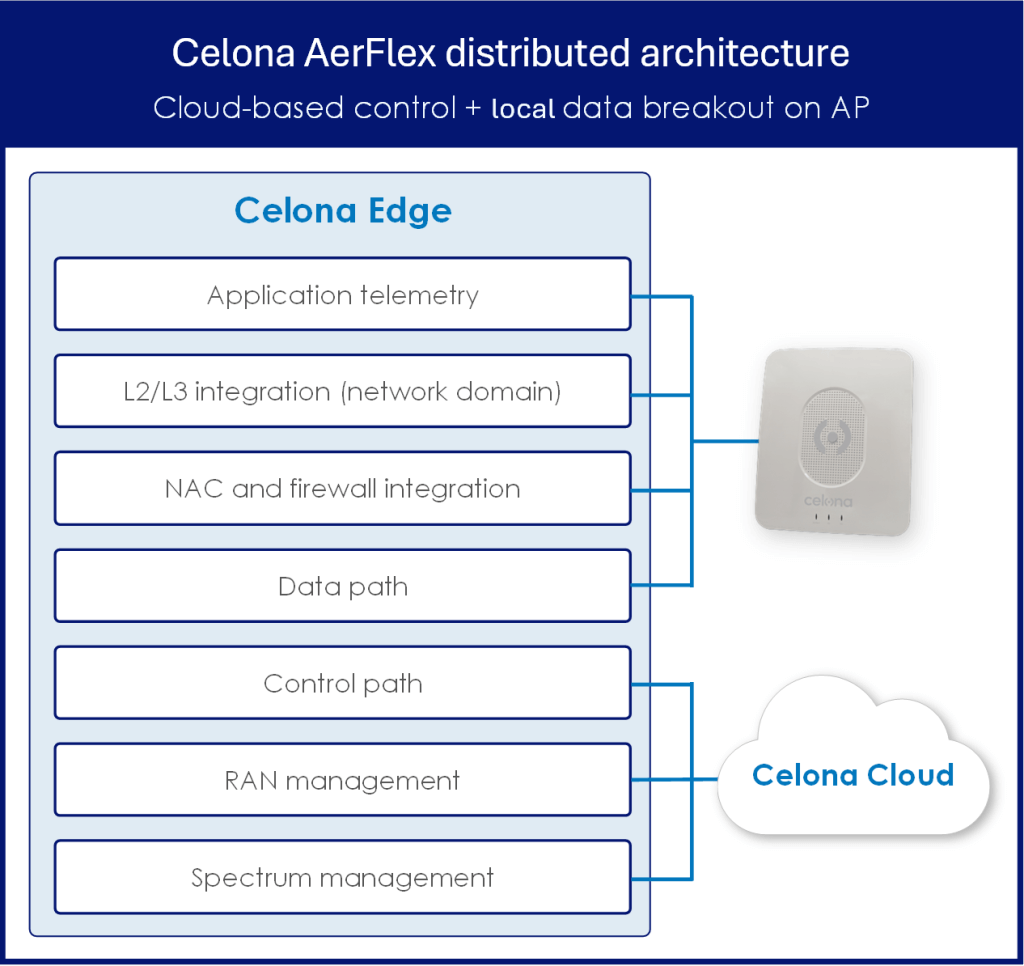As enterprises continue to embrace digital transformation and the emergence of AI, the demand for reliable, secure, and scalable wireless connectivity across increasingly distributed environments is surging. While Wi-Fi has served most office and carpeted spaces well, many industrial and non-traditional environments—such as manufacturing, logistics, retail yards, and refineries—continue to suffer from connectivity gaps. Enter private 5G.
In a recent conversation with Rajeev Shah, CEO and co-founder of Celona, we discussed the company’s latest innovation: AerFlex, a cloud-native private 5G solution engineered specifically to simplify and accelerate deployment in distributed enterprise environments. The solution represents a meaningful evolution in private cellular networking—one that mirrors the transformative shift that occurred when enterprise Wi-Fi moved to the cloud.
From Complexity to Simplicity: The AerFlex Architecture
Since its inception, Celona has been laser-focused on addressing the friction points that limit private 5G adoption. While early deployments focused on large-scale sites, customers quickly began demanding similar capabilities at smaller or remote locations, branch sites, distribution centers, or edge retail outlets. These smaller deployments, however, were hindered by the infrastructure-heavy nature of traditional private 5G architecture. AerFlex was developed to address this very challenge.
AerFlex takes inspiration from cloud-managed Wi-Fi architectures and adapts them to private 5G. In contrast to “lift and shift” cloud models that simply host the 5G core in a public cloud (resulting in latency and data sovereignty concerns), AerFlex enables local breakout of traffic directly at the access point. This means that while centralized control is maintained via a cloud console, data remains local, significantly reducing complexity, latency, and risk.
This approach is not only architecturally elegant, but also operationally practical. Customers can now plug a Celona 5G access point into their existing LAN, configure it via the cloud, and immediately gain the performance, QoS, and security benefits of cellular, without the operational burden of traditional telco-grade infrastructure.
A Unique Full-Stack Approach
What truly sets Celona apart is its vertically integrated architecture. From the radio to the 5G core and up through its operational and AI-enabled management layers, the Celona platform was designed from the ground up with the enterprise in mind. This full-stack ownership has, according to Celona, allowed it to innovate faster and optimize for real-world customer needs.

For example, Celona engineered its access points years ago to include the compute capacity needed for local data plane functions. This foresight enabled the AerFlex rollout to rely on already-deployed hardware in many cases, reducing time-to-value and preserving existing investments.
Moreover, Celona’s support for converged LTE and 5G radios within the same AP allows customers to transition at their own pace. Organizations with existing private LTE environments can seamlessly migrate to 5G without swapping out infrastructure, a major operational win.
Unlocking New Uses Cases and Markets
AerFlex effectively removes the economic and technical barriers that have historically confined private 5G to large, centralized facilities. By dramatically reducing infrastructure requirements, it unlocks a range of new use cases and verticals.
Shah highlighted retail and logistics as some of the early beneficiaries. From large industrial yard retailers to local storefronts for industrial parts, these businesses often require secure, reliable outdoor connectivity that Wi-Fi can’t reliably deliver. Similarly, in existing verticals like oil and gas or manufacturing, AerFlex now makes it feasible to extend private 5G to smaller sites, remote locations, and even upstream drilling operations where only one or two access points may be needed.
In addition to industrial use cases, Celona is beginning to see interest from general enterprise environments, offices, campuses, and mixed-use spaces, where organizations want to complement Wi-Fi with private 5G for enhanced security, deterministic performance, and improved mobility.
One particularly compelling example was a customer with 2,500 global sites, each requiring a small number of APs. Prior to AerFlex, only a few dozen sites were considered feasible for deployment. Now, the organization is evaluating full-scale rollout across all locations, a massive productivity and standardization opportunity.
Overcoming Data Sovereignty and Security Concerns
As distributed private 5G grows, so do concerns around data privacy, sovereignty, and regulatory compliance. AerFlex was explicitly designed to address these requirements.
By keeping the data plane local and only transmitting control plane data to the cloud, AerFlex adheres to strict data localization mandates. Celona has also invested heavily in compliance certifications, including SOC 2, and has implemented region-specific cloud deployments to meet customer needs around the world.
This architecture ensures that organizations in regulated industries, such as petrochemicals, logistics, and retail, can deploy private 5G with confidence.
Channel Partner Opportunities
For Celona’s partner ecosystem, AerFlex significantly expands the addressable market. System integrators and VARs now have the ability to deliver private 5G solutions into previously untapped locations. Partners were instrumental in validating the need for AerFlex, with many pushing for its release as early as six months ago to address pent-up customer demand.
Importantly, AerFlex enables partners to move up the value chain. Rather than just integrating network components, they can focus on delivering business outcomes, such as automation in warehouses, improved field worker productivity, and enhanced video surveillance, on top of the network.
The Default Model for Private 5G?
When asked about the future, Shah confidently positioned AerFlex as the default deployment model for the majority of enterprise private 5G environments. However, he acknowledged that there will still be scenarios, such as those involving high-speed robotics or real-time edge AI inference, where on-prem edge compute will be required.
Still, the vast majority of use cases, particularly those driven by coverage, security, and reliability in smaller sites, will benefit from the simplicity and scalability that AerFlex offers.
OurANGLE
Celona’s launch of AerFlex could be the pivotal moment in the evolution of private 5G. By shifting the architecture to mirror the simplicity of cloud-managed Wi-Fi, Celona is removing many of the historic barriers to adoption, allowing enterprises to standardize on private 5G as a strategic wireless solution.
In an era where wireless capacity, distributed edge connectivity, and security are more important than ever, AerFlex has the potential to make private 5G as ubiquitous and approachable as Wi-Fi. For IT and OT teams looking to modernize operations and prepare for an AI-powered future, this is a development worth watching closely.



